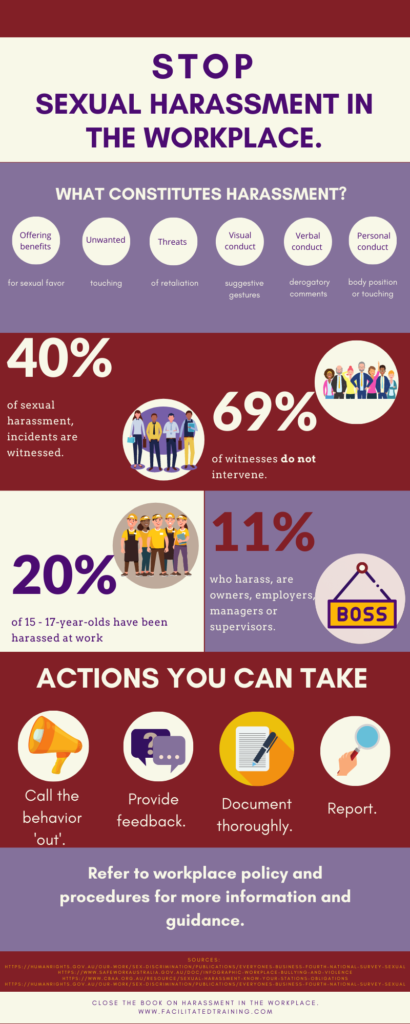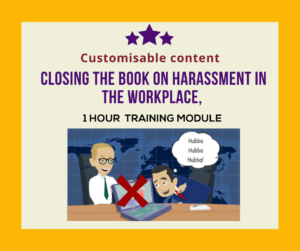Stopping Harassment in the workplace.
The #meetoo and #timesup social media campaigns have led to an unprecedented awareness of sexual harassment in the workplace. In news outlets around the world, institutions, organisations, and high-profile individuals are actively being named and shamed. Recently in Australia there have been high profile cases of alleged harassment in the Federal Government, Secondary Schools, and Entertainment industry.
Social media and access to pornographic sites, has also created a funnel of sexualised teenagers that year on year are entering the workplace.
Social media has also enabled victims to be heard. Investigations, or lack of action is no longer tolerated. Gone are the days, where it was acceptable to be ‘handsy’, dismissing complaints that ‘boys will be boys’ and utilising positions of power for sexual gratification.
Provide a safe environment to your employees.
Organisations have a duty of care to their employees to create a culture and environment that is safe and allows people to do their best work. If an organisation fails in this task, you quickly begin to see an increase in workplace bullying. As an employer, it is critical to ensure that proactive training and education occurs, to ensure a safe workplace.
Let us take a moment to review the impacts and costs of taking a reactive approach to stopping harassment in the workplace.
According the Deloitte, In 2018, workplace sexual harassment cost $2.6 billion in lost productivity and $0.9 billion in other financial costs. Each case of harassment represents around 4 working days of lost output. Employers bore 70% of the financial costs, government 23% and individuals 7%
Reports from the NSW Department of Education claims costs of almost $26million related to psychological injuries due to bullying, violence, and harassment.
Which raises the question:
What is the current state of workplace bullying, and what does it cost organisations?
The cost to productivity
- On average claimants miss 9 to 10 weeks of work whilst dealing with the issues from the bullying.
- Further to this, staff often state that on return to work they still find difficulty in performing their function, and in many cases leave their employment. This again costs the organisation in recruitment and further loss of productivity.
The report also states that claims of mental stress caused by workplace pressures or environment leads to a cost of $20,955 (on average), with the claimant missing 9 to 10 weeks of work. This again means that organisations lose productivity.
“Workplace bullying costs Australian employers between $6–$36 billion dollars every year when hidden and lost opportunity costs are considered.” – Australian Human Rights Commission
What can you do on individual level?
Anyone who witnesses or becomes aware of potential instances of sexual harassment should report it to a supervisor, manager, or designee.
It can be uncomfortable and scary, but it is important to tell coworkers “that’s not okay” when you are uncomfortable about harassment happening in front of you.
It is unlawful for an employer to retaliate against you for reporting suspected sexual harassment or assisting in any investigation.
Remember, ‘calling it out’ does not mean you need to physically intervene when you witness an incident or violence. Your response should not be hostile or aggressive.
- Give a disapproving look to show a behaviour or statement is not okay. Shake your head or roll your eyes.
- Leave a pointed and uncomfortable silence.
- Make a light-hearted comment: “What century are you living in?”
- Check in with the person affected: “I heard what he just said – are you okay?”
- Privately let them know the behaviour is not okay: “The joke you made in yesterday’s meeting was not funny, and actually not okay.”
- Calmly disagree and state that the comment is wrong or unacceptable: “I know you probably didn’t mean it, but I found what you said to be offensive.”
- Speak up and educate by explaining why you disagree: “Actually evidence shows the vast majority of women do not make up false claims of sexual assault” (you could use the Key Facts in this toolkit).
- Challenge the logic: “That’s not my experience.” or “What makes you think that?”
- Stand up for the person affected: “Michelle was saying something, and you cut her off again.”
- Make eye contact with the person affected – let them know you’re an ally.
- Show your emotion: “It actually makes me sad/uncomfortable when you say that.”
- Support others when they call it out: “I agree, that’s not funny.”
- Appeal to their better self: “Come on, you’re better than that.”
- Report the behaviour to management, or via incident reporting systems if available.
What can you and your workplace do?
- Organisations should include policy and procedures regarding harassment free workplace in induction and onboarding packs.
- Dedicated training to this topic should also occur on a annual basis.
- Hold employees accountable to the policy and procedure.
- Create a calendar of communications reiterating the importance of respect in the workplace.
- Lead by example
- Schedule training for manager and supervisors detailing their additional responsibilities regarding reporting and investigating.
- Create a whistle blower hotline so employee can report issues anonymously.
- Support those who have made a claim
The need for ongoing education and training, including behavioural change is compelling for all organisations.
Organisations and institutions that are proactively engaging their workforce, setting expectations and hold employees to account will reap the benefits of a respectful, trusting and engaged workforce.
Stopping harassment in the workplace training. Editable, 1 hour training materials
Closing the book on Harassment in the workplace.
Sexual harassment is serious business, it can create tension in the workplace, reduce productivity, and potentially leave significant emotional and financial devastation in its wake. This course has been designed to increase employee understanding of sexual harassment and its prevention. The workshop also recognizes that in addition to knowledge of the law, preventing harassment is largely dependent on workplace culture, vales and behaviours that are encourage or discouraged.
This interactive one hour course has been developed to provide the learner with an understanding of how to recognize and avoid behaviour that could be considered sexual harassment, and what to do if they are being subjected to or witness this type of behaviour.
Our workplace anti-harassment training for employees emphasizes that it’s not just managers and senior leaders are the custodians of an organisation’s workplace culture.
During this Anti Sexual harassment course, employees will learn about:
- The importance of harassment prevention in the workplace.
- How to recognize and avoid behaviour that could be considered sexual harassment
- What to do if you are being subjected to or witness this type of behaviour
- Build a proactive approach to respond to and manage sexual harassment situations from the point of view of an involved party or a bystander
- Understand the employees’ rights and managers’ responsibilities in preventing and managing workplace issues
- Participate in group discussions, interactive exercises, and scenarios to transform key information into actions and new behaviors
Flexible and accessible.
“Closing the book on sexual harassment in the workplace” training is designed to be highly experiential while also offering flexibility to further customize the training materials to reflect your organisation.
Interactive sessions.
Our 1-hour interactive, workshop-style sessions include discussion, Q&A, Video,, exercises, workbooks, and presentations and detailed facilitator guide.
This 1 Hour adult learning centred course has been created for the busy trainer or line manager that wants to get a message across but needs to reduce the impact to working operations.
- Lunch and learn sessions,
- Add the topic to your leadership curriculum
- Professional development during team planning days
- Conference workshops
- Stand alone,& refresher training
Short, succinct 1 Hour professional development courses enable you to deliver effective training sessions that get the key message across and retain participant involvement.
- Save hours of research and development time. We have done all the hard work so you can focus on the training delivery
- Own complete rights to edit, copy, and reuse the training materials. You can even brand it with your business logo and name.
- Download all training courses and course-ware packages immediately in their source files.
Closing the book on harassment in the workplace training materials includes:
- Detailed Trainers / Facilitator Guide
- Targeted explainer video
- Slide Deck
- Learner Workbooks
- Adult centred training activities
- Learner quiz
- Inforgraphic x 2
- Pre course welcome email template
- A self-paced learning plan for learning application back in the workplace
- Learner Attendance Certificate
- Attendance record
- Training evaluation sheet
Duration: 1 hour
Audience: Employees at all levels.
INVESTMENT: $750.00 (AUD) + GST
About Facilitated Training.
Winner of HRD magazine Service Provider of the year 2020
Learning and Development should not get in the way of business. It should help business excel. That’s what we believe at Facilitated Training. And if that means doing things differently, then so be it.
Our mission is to help organisations thrive through quality, editable professional development training materials and resources. We are not like other training companies; we won’t charge you for every minute of courseware development. Instead, our fixed-priced product ensures you have unlimited access to customisable training materials and our easy-to-understand facilitator guides.
We keep things simple. It is about making things easier, saving you time, removing barriers, and giving you the freedom to do what you love. We want to build a relationship and create a beneficial partnership that goes beyond the menial day-to-day tasks and helps you identify commercial challenges and opportunities.
Facilitated Training can assist your business with everything from leadership training, customer service and other soft skills training, to short courses, lunch and learn materials, reference guides, templates, and more.
Leaving the creation of training materials to us, reduces risks and gives you more time to dedicate to what really matters – the people.
If you are in HR or operations and need learning and development assistance, get in touch today and let’s chat.
hello@facilitatedtraining.com +61 412299202


